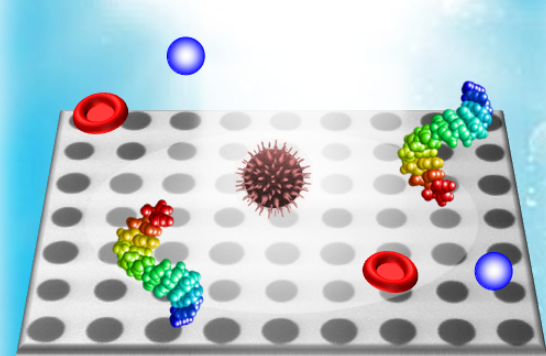Sensors and Biophotonics
The Project Group “Sensors and Biophotonics” aims at exploring innovative photonics concepts for the creation of biological and chemical sensors addressing some key societal challenges: the increasing demand for sanitary and environmental analysis, as well as the need for faster, more reliable and more cost-effective medical diagnostics.
Approach
Our approach is defined by the blending of original fundamental photonics concepts with an applied vision on the current major challenges of optical sensing:
- Photonics engineering: our main focus is the study of new and innovative concepts from integrated optics, photonic crystals and/or plasmonics in views of optimizing the interaction between light and the targeted analytes. This allows for the development of highly-sensitive and compact generic transducers, which are suitable (if required) for molecular screening, via the integration of sensor arrays enabling label-free parallel sensing of various molecules.
- Application-oriented vision: this second major aspect of our activities is implemented thanks to a close interaction with our partners from the Biotechnologies-Health axis at the INL, as well as external collaborations (CEA-Leti, industrial partners). Our objective is to design and study our devices while taking into account the issues and requirements linked to the targeted application, such as performances in real environments, industrial fabrication, micro-fluidics or surface functionalization. Such a vision about applications also allows for smart choices in terms of materials: e.g., devices based on silicon or silicon nitride for compatibility with a technological fabrication in microelectronics facilities, devices in polymers for specific sensing of organic compounds, or integration of metallic structures for localized surface functionalization.
This approach leads to original developments in terms of new sensing principles and new modelling tools (multi-scale and multi-materials). It also addresses various technological challenges, such as micro-nano-patterning of specific materials (polymers, porous silicon), 3D integration of sensor arrays or hybrid integration of metallic structures on dielectric platforms.
Topics
- Guided optics devices: this topic explores innovative concepts based on guided optics (waveguides, resonators, hybrid metal-dielectric structures), which are compatible with an integration onto a microelectronics platform. The targeted applications lie in the area of biomolecule sensing.
Collaborations: INL Biotechnologies-Health axis, ST Microelectronics, LN2
Contact: Régis Orobtchouk - Photonic crystal chips: this topic aims at exploring different facets of photonic-crystal based sensing for the creation of biochemical (or medical) diagnostic systems. In particular:
- Development of devices for molecular screening applications, with the objective to create systems fulfilling the requirements for “point-of-care” use, i.e., systems that are fast, low-cost, and compatible with mass production as well as with cost-effective, compact and lens-less reading systems.
Collaborations: INL Biotechnologies-Health axis, CEA-Leti, Avalun
Project: ANR CLIPO
Contact: Cécile Jamois - Development of optical nano-tweezers for the trapping and the study of mechanical properties of nano-objects. The targeted applications lie in the microfluidics domain, in particular medical diagnostics based on the deformation properties of cells.
Collaborations: INL Biotechnologies-Health axis
Contacts: Taha Benyattou
- Development of devices for molecular screening applications, with the objective to create systems fulfilling the requirements for “point-of-care” use, i.e., systems that are fast, low-cost, and compatible with mass production as well as with cost-effective, compact and lens-less reading systems.
Emerging topics:
- Devices based on polymers for the specific sensing of volatile organic compounds (VOC): this highly-exploratory topic aims at developing innovative fabrication techniques, as well as new approaches of optical sensing based on the deformability of polymers, in view of developing sensors that are specifically designed for VOC sensing.
Collaborations: INL Biotechnologies-Health axis
Contact: Lydie Ferrier - Systems for phase detection: this project explores alternative techniques to the detection via intensity monitoring. More specifically, the development of systems for interference measurements, based on holography, enables very low limits of detection to be reached.
Collaborations: INL Biotechnologies-Health axis
Contacts: Lotfi Berguiga
Staff
- Coordinator: Cécile Jamois
- Permanent: Taha Benyattou, Régis Orobtchouk, Lydie Ferrier, Lotfi Berguiga
- PhD & Post-doc. : Nicolas Gaignebet





